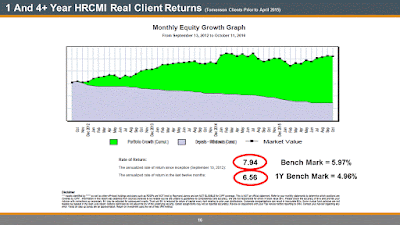2016 Theme #8:
We Are In A Low Return Environment
For those of you who follow our client weekly webinar
you will know that we have a series of 8 themes which we have been following for this calendar year. We touch on this particular one from time to time because with slow economic growth, low inflation and meagre year over year earnings growth (negative for 5 consecutive quarters), we think that investors are placing too much emphasis on the stock market in an attempt to squeeze out what historically has been a pretty decent return on average and this puts them in a higher risk category.
We also disclaim (each week) that historical returns are in no way a guarantee of future returns.
Have a look at the equity benchmark returns for the last 5 years (MSCI All Country World Index):
Pretty good and steady returns until May of 2015, but the index is now really only where it was back in mid-2014 (no price appreciation, just dividends) and so the 3 year annualized total return is a relatively light 3.66% vs. the 5 year return of 8.91%.
On the bond side of the equation:
Bonds have out-performed equities over the last 3 years.
When you look at the combined 60/40 and 40/60 returns (and allow for fee's and MER costs):
The 5 year returns have been pretty much in line with the multiple year (20-25 year) averages but the most recent returns (3 and 1 year) have been well below average because we have entered into an era of lower than average returns (i.e. A Low Return Environment)
Further, according to a Bloomberg story and a study by the investment advisory group Research Affiliates, the odds of getting a 5% or better return on a balanced 60/40 portfolio over the next 10 years are 0%.
At High Rock, with this scenario in mind we (a year and a half ago) created an additional tactical portfolio model as a compliment to the basic 60/40 (equity model/fixed income model) standard balanced portfolio models to try and find a solution to something that we saw coming.
Sitting in a fully invested 60/40 portfolio with the low return scenario and the possibility of both asset classes moving in a correlated fashion when normally they move in a non-correlated fashion (see the separate 3 year returns above where bonds out performed equities) is a recipe for potentially significantly lower returns (and potentialy greater levels of volatility) than the average.
Time to get proactive (we have for our clients and they are nicely ahead of the benchmark returns), if you haven't already done so.
Feedback...
If you would like to receive this blog directly to your inbox...























